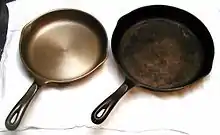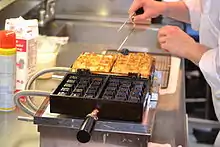Seasoning (cookware)
Seasoning or curing is the process of treating the surface of a cooking vessel with heated fat or oil in order to produce a corrosion-resistant and stick-resistant coating.[1][2] It is required for cast-iron cookware and carbon steel, which otherwise rust rapidly when heated in the presence of oxygen and water, even in small quantities such as in drippings from dry meat. In addition, food tends to stick to unseasoned iron and carbon steel cookware. Some cast-iron and carbon steel cookware is pre-seasoned by manufacturers, but most needs to be seasoned by the users.


Stainless steel and cast aluminium do not require protection from corrosion, but seasoning reduces sticking.[3] Other cookware surfaces are generally not seasoned.
Methods of seasoning
Food sticks easily to a bare metal pan; it must either be oiled or seasoned before use. The coating known as seasoning is formed by a process of repeatedly layering extremely thin coats of oil on the pan and pyrolytically decomposing each layer with high heat for a time. This process is known as "seasoning"; the color of the coating is commonly known as its "patina" - the base coat will darken with use.
To season a pan (e.g., to season a new pan, or to replace damaged seasoning on an old pan), the following is a typical process: First the cookware is thoroughly cleaned to remove old seasoning, manufacturing residues or a possible manufacturer-applied anti corrosion coating and to expose the bare metal. If it is not pre-seasoned, a new cast iron skillet or dutch oven typically comes from the manufacturer with a protective coating of wax or shellac; otherwise it would rust. This needs to be removed before the cookware is used.[4] An initial scouring with hot soapy water will usually remove the protective coating. Alternatively, for woks, it is common to burn off the coating over high heat (outside or under a vent hood) to expose the bare metal surface. For already-used pans that are to be re-seasoned, the cleaning process can be more complex, involving rust removal and deep cleaning (with strong soap or lye,[5] or by burning in a campfire or self-cleaning oven[6]) to remove existing seasoning and build-up.
Then several times the following is performed:
- applying a very thin layer of animal fat or cooking oil (ranging from vegetable oil to lard, including many common food-grade oils)
- polishing most of it off so that barely any remains
- heating the cookware-usually above the smoke point-to generate a layer of seasoning.[7][8][9]
- The surface is then commonly cleaned, often polished flat with salt before the process is repeated multiple times
The precise details of the seasoning process differ from one source to another, and there is much disagreement regarding the correct oil to use. There is also no clear consensus about the best temperature and duration. Lodge Manufacturing uses a proprietary soybean blend in their base coats as stated on their website. Others use lard or animal fats. The temperature recommended for seasoning varies from high temperatures above 260 °C (500 °F) to temperatures below 150 °C (302 °F). Some say that a temperature around the smoke point of the oil or fat should be targeted since this will allow vaporization of the lighter hydrocarbons from the oil, leaving behind heavier molecules for optimal polymerization or carbonization to occur. There is also no consensus on the correct duration of heating: from half an hour to an hour is often recommended.
Seasoning a cast iron or carbon steel wok is a common process in Asia and Asian-American culture. While the vegetable oil method of seasoning is also used in Asia, a traditional process for seasoning includes the use of Chinese chives or scallions as part of the process.[10]
Surface chemistry
In pan seasoning, the oil or fat is converted into a hard surface at or above the high temperatures used for cooking.
When oils or fats are heated in a pan, multiple degradation reactions occur, including decomposition, autoxidation, thermal oxidation, polymerization, and cyclization.[11][12] Often a pan's seasoning is uneven, and over time it will spread to the whole pan. Heating the cookware (such as in a hot oven or on a stovetop) facilitates the oxidation of the iron; the fats and/or oils protect the metal from contact with the air during the reaction, which would otherwise cause rust to form. Some cast iron users advocate heating the pan slightly before applying the fat or oil to ensure that the pan is completely dry.[13][14]
The seasoned surface is hydrophobic and highly attractive to oils and fats used for cooking. These form a layer that prevents foods, which typically contain water, from touching and cooking on to the hydrophilic metallic cooking surface underneath.
The seasoned surface will deteriorate at the temperature where the coating breaks down. This is typically higher than the smoke point of the original oils and fats used to season the pan. Thus old seasoning can be removed at a sufficiently high temperature, as found in oven self-cleaning cycles.
Care
Some food writers advise against using seasoned pans and dutch ovens to cook foods containing tomatoes, vinegar, or other acidic ingredients because these foods would eventually remove the protective layer created during the seasoning process.[15][16][17] Tests conducted by America's Test Kitchen found that, while cooking a highly acidic tomato sauce for over 30 minutes produced a metallic taste, cooking acidic food in a well-seasoned pan for a short time is unlikely to have negative consequences.[18][19][20][21][22]
Cast iron pots are best suited to cook food high in oil or fat, such as chicken, bacon, or sausage, or used for deep frying. Cleaning (except prior to seasoning), is often carried out without the use of detergent. Some cookbook authors recommend only wiping seasoned cookware clean after each use or using other cleaning methods such as a salt scrub or boiling water.[23] The protective layer itself is not very susceptible to soaps, and many users do briefly use detergents and soaps.[18] However, cast iron is very prone to rust, and the protective layer may have pinholes, so soaking for long periods is contraindicated as the layer may start to flake off.
Unlike commercial non-stick coatings such as Teflon, with which metal cooking utensils are not used because they damage the surface, seasoned surfaces tend to be self-reforming, so they allow the use of such utensils. These are of course much more effective in scraping off food than the softer utensils used with non-stick pans.[24][22]
Bluing
In the process of bluing, an oxidizing chemical reaction on an iron surface selectively forms magnetite (Fe3O4), the black oxide of iron (as opposed to rust, the red oxide of iron (Fe2O3)). Black oxide provides some protection against corrosion if also treated with a water-displacing oil to reduce wetting and galvanic action. Bluing is often used with carbon steel and cast iron pans in conjunction with seasoning.
See also
References
- Harold McGee, On Food and Cooking: The Science and Lore of the Kitchen, rev. ed., 2007, p. 790
- Cherie Mason, J. Kenji López-Alt, The Food Lab: Better Home Cooking Through Science, W.W. Norton, 2015, chapter "Essential kitchen gear", section "Pots and Pans"
- https://www.epicurious.com/expert-advice/how-to-turn-stainless-steel-skillet-nonstick-article
- "Care of Cast Iron Pots and Pans". Retrieved 2008-01-03.
- "Cleaning Cast Iron With Lye". Retrieved 2008-01-03.
- "How to use your self-cleaning oven for cleaning cast iron". Retrieved 2008-01-03.
- "Lodge - Seasoned Cast Iron". Lodge Manufacturing. Retrieved 2012-12-15.
- "Care and seasoning of your wok". Archived from the original on 2008-05-09. Retrieved 2008-01-03.
- "Seasoning Frying Pans".
- Young, Grace (2004). The Breath of a Wok: Unlocking the Spirit of Chinese Wok Cooking Through Recipes and Lore. Simon & Schuster. p. 48. ISBN 0-7432-3827-3.
- Chang, S. S., Peterson, R. J. & Ho, C. T. (1978) Chemical reactions involved in the deep-fat frying of foods. J. Am. Oil Chem. Soc. 55: 718–727.
- Paul, S. & Mittal, G. S. (1997) Regulating the use of degraded oil/fat in deep-fat/oil food frying. Crit. Rev. Food Sci. Nutr. 37: 635–662.
- "Seasoning Cast Iron". Retrieved 2008-01-03.
- "Seasoning Cast Iron Pots". Cooking Louisiana. Retrieved 2007-12-31.
- Chodosh, Sara (November 8, 2019). "Seasoning your cast iron pan isn't enough". Popular Science. Retrieved 14 December 2020.
- MacMullin, Heather (January 22, 2019). "What Not To Cook In A Cast Iron Pan, Starting With Tomato Sauce". Chatelaine. Retrieved 14 December 2020.
- Thomson, Julie R. (August 16, 2017). "Think Twice Before Cooking Tomatoes In Your Cast Iron Skillet". HuffPost. Retrieved 14 December 2020.
- "The Truth About Cast Iron". America's Test Kitchen. Retrieved 14 December 2020.
- Cericola, Lisa (July 18, 2017). "6 Things You Didn't Know About Your Cast Iron Skillet". Southern Living. Retrieved 14 December 2020.
- Henry, Alan (May 1, 2016). "It's Okay to Cook Acidic Dishes in Cast Iron (and Other Cast Iron Myths, Debunked)". Lifehacker. Retrieved 14 December 2020.
- Bonem, Max (January 14, 2020). "9 of the Wildest Misconceptions About Cast Iron, Debunked". Food & Wine. Retrieved 14 December 2020.
- Tracy, Erika (July 30, 2020). "The 5 Biggest Things People Get Wrong About Cast Iron Cookware". Kitchn. Retrieved 14 December 2020.
- Emery, Carla (2003). The Encyclopedia of Country Living: An Old Fashioned Recipe Book. Sasquatch Books. p. 41. ISBN 1-57061-377-X.
- Cast Iron Cookbook: The Ultimate Guide to Cast Iron Cooking By Julia Grady
Further reading
- Gao, Chenxi; Yang, Na; Li, Cunpu; Wang, Xi; Yu, Xun; Zhang, Ling; Wei, Zidong (June 2020). "Seasoning Chinese cooking pans: The nanoscience behind the Kitchen God's blessing". Nano Materials Science: S2589965120300416. doi:10.1016/j.nanoms.2020.06.001.
